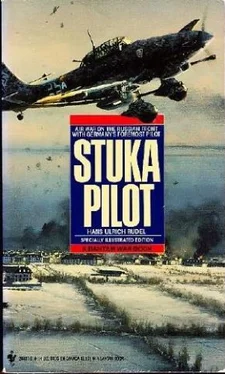“I assure you, sir, it wasn’t intentional.”
“Rubbish! You are exactly that kind of idiot You absolutely determined to attack the railway station.”
“You overestimate me, sir.”
“The future will prove I was right. Incidentally we are going out again presently.”
An hour later I am flying next to him with another aircraft again in the Luga sector. In the evening I work off my inner tension and my physical lassitude in a game.
The following morning our objective is Nowgorod, where the big bridge that spans the Wolchow collapses under our bombs The Soviets are trying to get as many men and as much material as possible across the Wolchow and the Lowat, which flows into Lake Ilmen from the South, before it is too late. Therefore we have to keep on attacking the bridges. Their destruction delays the enemy, but not for long; we very soon realize that Pontoons are quickly constructed in between them and in this way the Soviets perseveringly patch up the damage we have caused.
This constant operational flying without intermission brings on many symptoms of fatigue, sometimes with distressing results. The skipper is very quick at noticing them, too. Operational instructions from the wing, transmitted over the telephone at midnight or even later, must now be listened to and taken down by two of us. On more than one occasion misunderstandings have arisen in the morning for which every one is convinced that the others blame him. The reason is really general exhaustion.
The C.O. and I are detailed to listen jointly to the wings nocturnal briefings. One night the telephone rings in the squadron tent. It is the wing commander on the line.
“Steen, we meet our fighter escort tomorrow morning at 5 A.M. over Batjeskoje.”
The exact point is very important. We hunt for it on the map by the light of a pocket torch, but we find no Batjeskoje. We have no clue as to where to look for it.
Our desperation is as vast as Russia. Finally he says: “I am sorry, sir. I can’t find the place on the map.”
Now the wing commander’s angry voice yaps in his Berlin accent: “What! Call yourself a squadron leader and don’t know where Batjeskoje is!”
“Can you please give me the map reading, sir,” says Steen.
A lengthy silence, endlessly prolonged. I look at him, he looks at me. Then suddenly: “Damned if I know the place either, but I’m putting Pekrun on the line. He knows where it is.”
His adjutant then quietly explains the exact location of the tiny village in the fen lands. A peculiar fellow, our wing commander; when he is angry or when he particularly wishes to be friendly, in either case, he talks like a typical Berliner. Where discipline and system are concerned our wing owes a lot to him.
4. THE BATTLE FOR THE FORTRESS OF LENINGRAD
The centre of the fighting is gravitating more and more Northwards. So, in September 1941, we are sent to Tyrkowo, South of Luga, in the Northern sector of the Eastern front. We go out daily over the Leningrad area where the army has opened an offensive from the West and from the South. Lying as it does between the Finnish Gulf and Lake Ladoga, the geographical position of Leningrad is. a big advantage to the defenders since the possible ways of attacking it are strictly limited.
For some time progress here has been slow. One almost has the impression that we are merely marking time.
On the 16th September Flight Lieutenant Steen summons us to a conference. He explains the military situation and tells us that the particular difficulty holding up the further advance of our armies is the presence of the Russian fleet moving up and down the coast at a certain distance from the shore and intervening in the battles with their formidable naval guns.
The Russian fleet is based on Kronstadt, an island in the Gulf of Finland, the largest war harbour in the U.S.S.R.
Approximately 12 ½ miles from Kronstadt lies the harbour of Leningrad and South of it the ports of Oranienbaum and Peterhof. Very strong enemy forces are massed round these two towns on a strip of coast some six miles long. We are told to mark all the positions precisely on our maps so as to ensure our being able to recognize our own front line. We are beginning to guess that these troop concentrations will be our objective when FTt./Lt. Steen gives another turn to the briefing. He comes back to the Russian fleet and explains that our chief concern is the two battleships Marat and Oktobreskaja Revolutia . Both are ships of about 23,000 tons. In addition, there are four or five cruisers, among them the Maxim Gorki and the Kirov , as well as a number of destroyers. The ships constantly change their positions according to which parts of the mainland require the support of their devastating and accurate gunfire.
As a rule, however, the battleships navigate only in the deep channel between Kronstadt and Leningrad.
Our wing has just received orders to attack the Russian fleet in the Gulf of Finland. There is no question of using normal bomber-aircraft, any more than normal bombs, for this operation, especially as intense flak must be reckoned with. He tells us that we are awaiting the arrival of two thousand pounder bombs fitted with a special detonator for our purpose. With normal detonators the bomb would burst ineffectively on the armored main deck and though the explosion would be sure to rip off some parts of the upper structure it would not result in the sinking of the ship. We cannot expect to succeed and finish off these two leviathans except by the use of a delayed action bomb which must first pierce the upper decks before exploding deep down in the hull of the vessel.
A few days later, in the foulest weather, we are suddenly ordered to attack the battleship Marat; she has just been located in action by a reconnaissance patrol. The weather is reported as bad until due South of Krasnowardeisk, 20 miles South of Leningrad. Cloud density over the Gulf of Finland 5-7/10; cloud base 2400 feet. That will mean flying through a layer of cloud which where we are is 6000 feet thick. The whole wing takes off on a Northerly course. Today we are about thirty aircraft strong; according to our establishment we should have eighty, but numbers are not invariably the decisive factor.
Unfortunately the two thousand pounders have not yet arrived. As our single engined Stukas are not capable of flying blind our No. 1 has to do the next best thing and keep direction with the help of the few instruments: ball, bank indicator and vertical speed indicator. The rest of us keep station by flying close enough to one another to be able to catch an occasional glimpse of our neighbor’s wing. Flying in the dense, dark clouds it is imperative never to let the interval between the tips of our wings exceed 9-12 feet. If it is greater we risk losing our neighbor for good and running full tilt into an other aircraft. This is an awe-inspiring thought! In such weather conditions therefore the safety of the whole wing is in the highest degree dependent on the instrument flying of our No. 1.
Below 6000 feet we are in a dense cloud cover; the individual flights have slightly broken formation.
Now they close up again. There is still no ground visibility. Reckoning by the clock we must pretty soon be over the Gulf of Finland. Now, too, the cloud cover is thinning out a little. There is a glint of blue sky below us; ergo water. We should be approaching our target, but where exactly are we? It is impossible to tell because the rifts in the clouds are only infinitesimal. The cloud density can no longer be anything like 5-7/10; only here and there the thick soup dissolves to reveal an isolated gap. Suddenly through one such gap I see something and instantly contact Fit. Lt. Steen over, the radio.
Читать дальше












